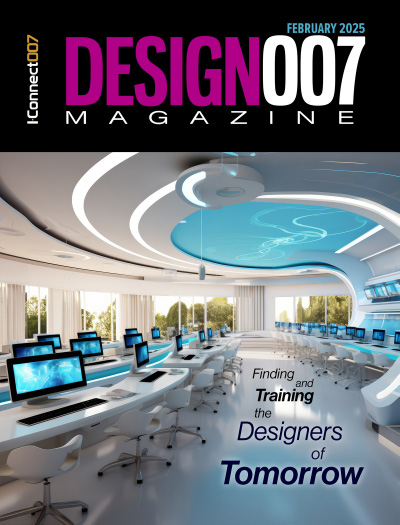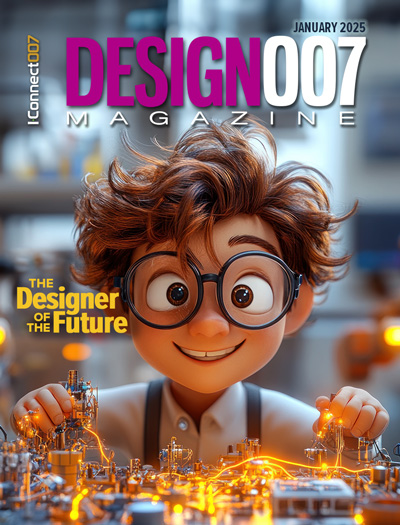-

- News
- Books
Featured Books
- design007 Magazine
Latest Issues
Current Issue
Training New Designers
Where will we find the next generation of PCB designers and design engineers? Once we locate them, how will we train and educate them? What will PCB designers of the future need to master to deal with tomorrow’s technology?

The Designer of the Future
Our expert contributors peer into their crystal balls and offer their thoughts on the designers and design engineers of tomorrow, and what their jobs will look like.

Advanced Packaging and Stackup Design
This month, our expert contributors discuss the impact of advanced packaging on stackup design—from SI and DFM challenges through the variety of material tradeoffs that designers must contend with in HDI and UHDI.
- Articles
- Columns
Search Console
- Links
- Media kit
||| MENU - design007 Magazine
WHMA’s Annual Global Leadership Summit Offers Technical Education Workshop on Strategic Practices for Success
November 28, 2023 | IPCEstimated reading time: Less than a minute
Neil Shah, senior technical director at alliantgroup, a tax and business consultancy, will present a technical education workshop, “Strategic Practices for Success: Outpacing Competitors, Optimizing Bids and Nurturing Top Talent,” on February 13, 2024, from 3:00-5:00 pm, at WHMA's Annual Global Leadership Summit in Myrtle Beach, S.C.
Shah will lead an interactive discussion on trends in the industry and provide practical advice on practices that manufacturers can implement immediately. He will detail recent legislative updates to powerful credits and incentives that have helped WHMA members claim millions in federal funds. Shah will explain how these changes apply to wire harness manufacturers and how they can benefit from these lucrative federal programs.
“In today's competitive market, businesses must be strategic in their approach to remaining competitive, lowering bids, and retaining skilled workers,” said David Bergman, WHMA executive director. “We look forward to learning how the alliantgroup, can help company owners in the cable and wire harness industry take full advantage of federal and state tax credits, incentives, and deductions in order to successfully compete both in the U.S. and abroad.”
Suggested Items
Apptronik, Jabil Collaborate to Scale Production of Apollo Humanoid Robots and Deploy in Manufacturing Operations
02/28/2025 | JabilApptronik, the AI-powered humanoid robotics company, and Jabil, a global leader in engineering, manufacturing, and supply chain solutions, have announced a pilot and strategic collaboration to build Apollo humanoid robots and integrate them into specific Jabil manufacturing operations.
Growth and Innovation at FCT
02/26/2025 | Marcy LaRont, I-Connect007During DesignCon, I met with Tony Plemel, senior applications engineer at Flexible Circuit Technologies (FCT), to discusses the company’s growth and expansion opportunities, including its expansion of its inTFlex EMS facility. In this interview, Tony explains how FCT’s commitment to customer service and focus on communication and responsiveness allow the company to leverage its capabilities for continued expansion.
It's Only Common Sense: Maximizing the Five Stages of Your Trade Show Exhibit
02/26/2025 | Dan Beaulieu -- Column: It's Only Common SenseI have been advocating for trade shows for years. I know they’re not cheap. Booth space, travel, hotels, promotional materials, and time away from the office can add up quickly. But they are one of the most significant investments your company will make in marketing and sales. If done right, trade shows can be a gold mine of opportunity to gain leads, build relationships, and showcase your business to the world.
Elementary, Mr. Watson From Classroom to Career—Bridging the Gap in PCB Design Talent
02/27/2025 | John Watson -- Column: Elementary, Mr. WatsonHas anyone else felt we're doing more with less in our industry and we constantly need more and better talent? Although we are in the middle of what I consider the golden age of the PCB industry in terms of innovation, we still don’t have the necessary talent to fill positions. We need to take a serious look at our industry, figure out how we found ourselves in this position, and what we can do to turn the situation around.
Global PCB Connections: How Technology Can Level the Playing Field
02/25/2025 | Jerome Larez -- Column: Global PCB ConnectionsTechnology can help us all become equal by leveling the playing field. It doesn’t matter where you build PCBs because the rules of physics are universal. There are several ways global standardization helps when it comes to working together to create the best possible products.


